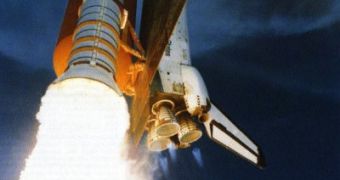The Solid Rocket Boosters (SRB) used on NASA's current space shuttles use solid fuel to get the thrust required to defeat the Earth's gravitational pull. The fuel is made of grains molded from a thermoset elastomer, fuel, oxidizer and catalyst. This fuel mixture is known as Ammonium perchlorate composite propellant (APCP), named after ammonium perchlorate, the most commonly used oxidizer.
Now, it seems that the space agency is experimenting with fuels, although it is not yet known if the present solid fuel will be replaced. On January 16, NASA performed a rocket engine test, whose fuel was methane, instead of solid chemicals.
"We were testing a methane engine," says project manager Terri Tramel of NASA's Marshall Space Flight Center (MSFC).
Still in an early stage of testing, the new engine was built and fired by the NASA contractor team Alliant Techsystems/XCOR Aerospace.
Methane (CH4) is the main component of natural gas, the same one used in domestic appliances. Burning one molecule of methane in the presence of oxygen releases one molecule of CO2 (carbon dioxide) and two molecules of H2O (water).
It is also abundant on other planets and celestial bodies, like Mars, Jupiter and Titan (the largest moon of the planet Saturn), and it could be harvested by future exploration missions that could make use of these free "refueling stations." Mars doesn't really have pure methane, instead it can be obtained through a chemical process of mixing carbon dioxide (CO2) with hydrogen (H), then heating the mixture to produce CH4 and H2O.
Thus, if fuel were waiting at the arrival, a rocket leaving Earth wouldn't have to carry so much propellant, reducing the cost of a mission. "Methane has so many advantages," continues Tramel. "The question is, why haven't we done this before?"
Surprisingly, methane has never been considered an option for powering spacecrafts before and scientists and engineers at Marshall, the Glenn Research Center and the Johnson Space Center are creating LOX/methane engines as an option for the future. "Several efforts are underway, including a rival LOX/methane main engine design by KT Engineering," notes Tramel.
"This work is funded by NASA's Exploration Technology Development Program and shows how technologies being developed for exploration may one day assist in future science missions," says Mark D. Klem, manager of the Propulsion and Cryogenics Advanced Development Project at the Glenn Research Center.
Other advantages of methane are taken into consideration, like the fact that it's not toxic, unlike present solid fuel, it can be stored at the much warmer and more convenient temperature of -161.6 degrees Celsius, as opposed to the -252.9 degrees Celsius for the same solid fuel, but most of all, it exists or can be made on many worlds that NASA might want to visit someday, including Mars.

 14 DAY TRIAL //
14 DAY TRIAL //